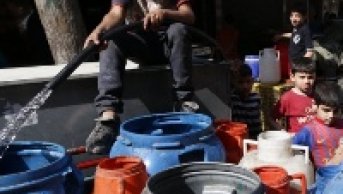‘Threat Multiplier’ Role of Drought in Arab Spring in Syria

The role of climate change and its impact on society were described as “threat multipliers” for the Arab Spring. Although rising food prices caused by drought are not the main reason for these events, they are believed to have acted as a trigger.
The Arab Spring broke out in Tunisia in early 2011, but popular and political mobilization had been on the rise due to social, environmental and economic problems for the previous couple of years. The growing tension between people and the government in Syria, and then the emergence of anti-government movements, especially in reaction to prolonged dry spells caused by climate change, are considered examples of this phenomenon.
According to studies conducted by the United Nations Development Program (UNDP), Syria, which was once a water-rich country, is now experiencing water scarcity due to its growing population, drought and a mismanagement of water resources.
The popular movements which had been developing in Middle Eastern countries since January 2011 broke out in Daraa, a poor agricultural area of Syria experiencing water scarcity, in March. Daraa is one of the biggest Syrian governorates, in the plains of Hauran, where agricultural activity is intense. Daraa has been facing water scarcity due to a fall in precipitation and a long-term mismanagement of water resources. Although the authorities pointed to an extended drought as the cause of water scarcity, the main reason for the problem is found to be the mismanagement of water resources, according to a report by the International Crisis Group titled “Popular Protest in North Africa and the Middle East (VI): The Syrian People's Slow-motion Revolution.”
The fact that local authorities allowed the illegal overuse of groundwater is one example of this mismanagement. The situation has caused substantial damage to the agricultural sector. Long-term water scarcity has also led to poverty and emigration from the region. Local tribes were caught between smuggling and the much-reduced agricultural sector, and thus popular tension increased due to a lack of support from the regime.
Moreover, the UN suggests that 6 percent of Syrians, or 1.3 million people, have been affected by drought. It is stated that the drought from 2006–2011 was the worst long-term drought, affecting 60 percent of Syria's land, known as the fertile crescent, and the Global Assessment Report on Disaster Risk Reduction (GAR) issued by the UN in 2011 stated that Syrians engaged in agriculture were in the most perilous position. As a result of the drought of 2006-2011, the al-Hasakah Governorate and southern Syria suffered a yield loss of around 75 percent, while livestock breeding and agriculture experienced a loss of 85 percent in northeastern Syria, and 160 villages were abandoned.
The International Federation of Red Cross and Red Crescent Societies' (IFRC) 2009 report states that the annual incomes of those engaged in agriculture decreased by 30 percent in three years because of drought. In January 2011, on the other hand, some 200,000 villagers migrated from rural areas around Aleppo to urban areas due to the decrease in agricultural yield. Malnutrition and disease were caused by drought, and issues such as migration, financial difficulties, unemployment and changing jobs resulted from the damaged agricultural sector.
In addition to the impact of climate change, which should not be underestimated, the most significant impact on agriculture in Syria was the mismanagement of water resources. Producing water-intensive cotton and wheat, Syria uses conventional irrigation methods and thus wastes a great amount of water. Besides, Syria sold the vast majority of its wheat reserves when global wheat prices were on the rise and then had to purchase wheat from other countries during dry spells.
Groundwater has started to be used intensely in agriculture. The area irrigated by groundwater increased from 650,000 hectares in 1985 to 1.4 million hectares in 2002. Also, the fact that the number of illegal wells has doubled to 213,000 in the last eight years decreased the groundwater tables, and wells near the sea have become salinated. The existing water problem has worsened through this process.
In early 2008, the US Embassy in Damascus warned of the effects of drought and stated that migration caused by drought would create social and economic pressures in the country that would undermine its stability.
While the drought of 2006–2011, which affected most parts of the world, caused trouble in wheat-exporting countries in terms of production, it appeared as high inflation of food prices in importing countries. Also, drought caused major damage to agriculture, especially in Syria and the Middle East, as well as creating rural-urban migration. The economic and social impacts of drought have played a major role in the rise of unrest in these countries. Although the implications of drought and water scarcity were not the main triggers of the Arab Spring that broke out in January 2011, they are one factor that accelerated the process.







